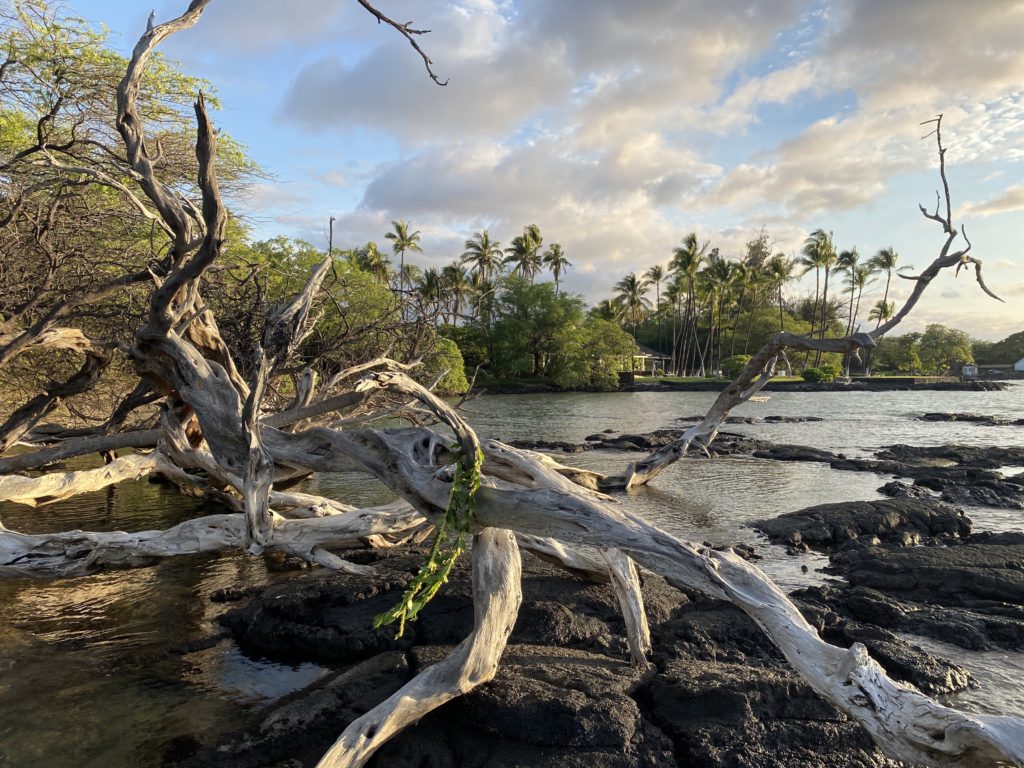
My dad and his brother spent their childhood summers at Puako Lot 4. They ran across the red-hot a`a with fishing nets, catching manini and looking for sharks. The Black Tip Reef Sharks are my cousins. There is a legend in Puako that a still-born child from the Kaono family was put to rest in the tidepools in front of what is now Lot 4. As the child descended into the water, they became a reef shark, and if you stand at the edge of the drop off long enough, it will visit you.
My great grandmother, Rebecca Lepeka Kaono, swept the floors of the church next to Puako Lot 4. Hokuloa Church was the first Christian church on the North West side of the island. My aunt Hoku is named after it, hoku meaning “star.”
Rebecca’s father, Joseph Kaono, tied his canoe to the fallen kiawe tree at Puako Lot 4. That was before it was divided into a lot, when everybody just knew it as where the Kaonos lived. He fished for a living and sold his findings at the market just north of Puako in Kawaihae, after sharing with the other families who lived between the boat ramp and Paniau. My favorite place to swim is right by Paniau, across the street from the lava-tube burial caves my ancestors now reside in. Joseph is the last member of our family to rest there.
You would think that this land is untouched by how I describe it; a picturesque painting containing the warm green of kiawe trees and the silicon sheen of lava rock. Compared to most parts of Hawai`i, the land is not as urbanized, but the vacation homes still seem endless. Walking down Puako Beach Drive, it looks as if they increase in square footage year after year.
My grandfather, Rebecca’s son, Johannes Wedemeyer, did everything he could to hold onto Puako Lot 4.
Since the development of a distinctly Hawaiian culture (after other Polynesian voyagers had crossed the pacific to settle there), Hawaii has used the ahupua`a system for managing land. This created triangular districts which organized communities and equipped citizens with all that they needed. The ahupua`a start at the middle of the island, in the backs of valleys, and follow streams down, opening up towards the ocean, providing both agricultural land and access to the ocean for the people who lived in each one. The land was not privately owned. Ali`i, the leaders and kings, had jurisdiction over land usage and whether certain places could be used by the people or not, or whether heiau (monuments) could be constructed, but otherwise, the land was the peoples’ to care for.
In 1848, under King Kamehameha the Third (known as Kauikeaouli), land was divided into three categories: land of the Crown, land for the government, and konohiki land. The konohiki lands functioned as ahupua`a, each administered by a chief. Some of it could be used by tenants (called Kuleana tenants) who were diligent to manage and increase the productivity of the land. This recharacterization of land is called the Great Māhele, or the great divide.
Then, land ownership became privatized. The Land Commission, established in 1847 just before the Māhele, allowed some of the Kuleana tenants to buy small parcels. They could legally obtain the land for a commutation fee, and in return would get a Land Commission Award, rooting them to that place. In this same decade, white American missionaries were profiting off of sugarcane, founding Christian schools for their children, obtaining roles in government, and establishing relationships with the monarchs. As the nation was colonized by more and more white, Christian Americans, cultural practices like hula, and later the Hawaiian language, `ōlelo Hawai`i, were banned.
In 1893, the American government and wealthy missionary families illegally overthrew the Hawaiian crown. A new provisional government took hold of Hawai`i, while our Queen Lilioukalani was locked in `Iolani Palace watching from the window.
My great-great-grandfather was a tenant under Kuleana rights during the overthrow, and the land that my family has cared for since the seventeenth century was under his name. At the turn of the century, the Land Commission (now completely Americanized) tried to bar him from renewing his Land Commission Award for the land in Puako. With a long process of fighting the commission and a fee of $220, he was permitted to keep the land under his management. In his parents’ lifetime, land had changed from a shared, foundational part of life, to something that had to be bought, something that could be kept from the people who had traditions and history tied to it. Land became material.
Just before Hawai`i was officially assumed as a state (still, illegally might I add), Puako was further divided. A road was constructed from the Lot 4 to Paniau, removing part of the coastal lava field and probably hundreds of hieroglyphs. The coastal area past what was now known as Lot 4 and Hokuloa Church was subdivided into spaces for plantation style vacation homes. Trees were cut down, beach access was obstructed, and fences were put up to conceal and hide more of what once belonged to all who cared for it. This is when Puako was “re-zoned.” Lots were either deemed residential or resort—seemingly the only two categories of living that Hawai`i appears to offer visitors. Lot 4 was covered by only kiawe leaves and stone since my dad was in elementary school, and when he was young the only structure on it was a shed. While the shed was probably meant for fishing poles, my dad and his brother treated it as if it were a castle for them to stay in to hide from the rising tides when they stayed at the lot. Since there was no grand house, no pool, and no concrete in sight, our land was deemed resort.
After my grandfather’s fourth stroke, my dad began working with him to decide the fate of Lot 4 before he passed on. My grandfather was the youngest of thirteen children, and was the legal owner of the land, managing it and bettering it throughout his life. As his health deteriorated, I visited Puako often, trying not to think about the possibility that it wouldn’t be ours if we couldn’t afford to keep it. I walked along the salt divets in the rock, placed black and white stones in the konane boards like I was playing chess against myself, and waited at the edge of the drop off for the shark.
The last time I was at Lot 4, it was for my grandfather’s funeral. He and my dad filed all of the paperwork, looked at options, land prices, zoning laws, claims to land through the Department of Hawaiian Homelands, and everything they could think of, but we couldn’t afford to buy the land before another bidder. His funeral was the last time I stood there as a Kaono descendant on the Kaono’s land.
The land and the earth do not exist to be categorized and challenged by people. The land exists to remember what has been done and who has done it. It exists to take care of the people who have respected it. It is not to be commodified or itemized in the name of being some sort of pioneer. I know that whoever now owns the kiawe driveway and the fallen trees does not know that Joseph’s canoe sat on those rocks, or that the shark is my cousin, but I am happy that I can continue to share that even if I am not skipping across the lava rock, barefoot.
Olivia Wedemeyer ’25

